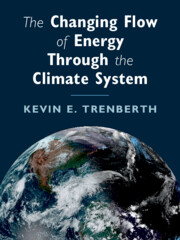Book contents
- The Changing Flow of Energy through the Climate System
- The Changing Flow of Energy through the Climate System
- Copyright page
- Contents
- Foreword
- Preface
- Acknowledgments
- 1 Earth and Climate System
- 2 Earth’s Energy Imbalance and Climate Change
- 3 Earth’s Energy Balance
- 4 The Sun–Earth System
- 5 Observations of Temperature, Moisture, Precipitation, and Radiation
- 6 The Climate System
- Flows of Energy
- 7 The Weather Machine
- 8 The Dynamic Ocean
- 9 Poleward Heat Transports by the Atmosphere and Ocean
- 10 The Changing Hydrological Cycle
- 11 Teleconnections and Patterns of Variability
- 12 El Niño
- 13 Feedbacks and Climate Sensitivity
- 14 Earth’s Energy Imbalance Estimates
- 15 Attribution and the Hiatus
- 16 Prediction and Projection
- 17 Emissions and Information
- 18 Climate Change and Environmental Issues
- Glossary
- Acronyms
- Bibliography
- Index
- References
10 - The Changing Hydrological Cycle
from Flows of Energy
Published online by Cambridge University Press: 25 February 2022
- The Changing Flow of Energy through the Climate System
- The Changing Flow of Energy through the Climate System
- Copyright page
- Contents
- Foreword
- Preface
- Acknowledgments
- 1 Earth and Climate System
- 2 Earth’s Energy Imbalance and Climate Change
- 3 Earth’s Energy Balance
- 4 The Sun–Earth System
- 5 Observations of Temperature, Moisture, Precipitation, and Radiation
- 6 The Climate System
- Flows of Energy
- 7 The Weather Machine
- 8 The Dynamic Ocean
- 9 Poleward Heat Transports by the Atmosphere and Ocean
- 10 The Changing Hydrological Cycle
- 11 Teleconnections and Patterns of Variability
- 12 El Niño
- 13 Feedbacks and Climate Sensitivity
- 14 Earth’s Energy Imbalance Estimates
- 15 Attribution and the Hiatus
- 16 Prediction and Projection
- 17 Emissions and Information
- 18 Climate Change and Environmental Issues
- Glossary
- Acronyms
- Bibliography
- Index
- References
Summary
The hydrological cycle fundamentally involves evaporation (E) of moisture from the land and vegetation or ocean surface into the atmosphere, and back again as precipitation (P) (Fig. 10.1). Evaporation produces evaporative cooling at the surface and moistens the air. It includes transpiration from plants in which water enters the atmosphere through the tiny stomata in leaves as photosynthesis occurs. Together these are called evapotranspiration. Precipitation and the relationships to humidity and sea surface temperatures (SSTs) were introduced in Section 5.4. Water vapor is moved around by the atmosphere, and the precipitation occurs elsewhere, often in preferred locations such as mid-latitude storm tracks or tropical monsoons and convergence zones.
- Type
- Chapter
- Information
- The Changing Flow of Energy Through the Climate System , pp. 140 - 161Publisher: Cambridge University PressPrint publication year: 2022

